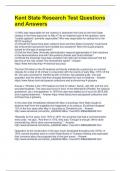Kent State Research Test Questions
and Answers
(1) Who was responsible for the violence in downtown Kent and on the Kent State
campus in the three days prior to May 4? As an important part of this question, were
"outside agitators" primarily responsible? Who was responsible for setting fire to the
ROTC building?
(2) Should the Guard have been called to Kent and Kent State University? Could local
law enforcement personnel have handled any situations? Were the Guard properly
trained for this type of assignment?
(3) Did the Kent State University administration respond appropriately in their reactions
to the demonstrations and with Ohio political officials and Guard officials?
(4) Would the shootings have been avoided if the rally had not been banned? Did the
banning of the rally violate First Amendment rights? - Answer-
https://www.kent.edu/may-4-historical-accuracy
The Kent 25 refers to the 25 students and faculty indicted by a grand jury on criminal
charges for a total of 43 crimes in conjunction with the events of early May, 1970. Of the
25, one was convicted for interfering with a fireman, two pleaded guilty, one was
acquitted, and the others had their charges dismissed for lack of evidence. - Answer-
https://www.library.kent.edu/special-collections-and-archives/may-4-glossary
Krause v. Rhodes is the 1975 federal civil trial for Allison, Sandy, Jeff, Bill, and the nine
wounded students. The case was found in favor of the defendants (Rhodes, the national
guardsmen, etc.) and appealed. In 1979 the case was settled out of court for $675,000
and a signed statement. - Answer-https://www.library.kent.edu/special-collections-and-
archives/may-4-glossary
In the years that immediately followed the May 4 shootings, Kent State sought to
distance itself from the tragedies that happened on its campus. Enrollment dropped
13% in the four years after May 4, according to Cleveland.com. - Answer-
http://www.kentwired.com/article_a45d3c9c-88ce-11ea-b97c-9f86dc86bd32.html
"Basically for five years, from 1970 to 1975, the university had had a commemoration
every year," he says. "And then in 1975, they said, 'Enough is enough. We're done
memorializing. We're done commemorating.'" - Answer-
http://www.kentwired.com/article_a45d3c9c-88ce-11ea-b97c-9f86dc86bd32.html
Opposition to the construction of the gym annex developed throughout the 1970s. In
1976, several students went to a Kent State Board of Trustees meeting and expressed
their concerns about the proposed site of the gym annex. - Answer-
http://www.kentwired.com/article_a45d3c9c-88ce-11ea-b97c-9f86dc86bd32.html
, "We all came out of there unified as a powerful new organization called the May 4
Coalition," Canfora says. "And we had listed eight demands. And we really started to
bond, personally and politically."
These demands included: never altering the site of the shootings, not punishing anyone
for the demonstration in Rockwell Hall or missing classes on May 4, naming buildings
for the four students killed, canceling normal university activities every May 4,
acknowledging the shootings as an injustice, maintaining university status for the Center
for Peaceful Change and reopening negotiations with the United Faculty Professional
Association. - Answer-http://www.kentwired.com/article_a45d3c9c-88ce-11ea-b97c-
9f86dc86bd32.html
The group known as the "Kent 25" was hit with another blow after the May 4 shootings.
They were indicted five months later on charges connected with the demonstration that
day or the ROTC building fire three days before. Some claim they were merely caught
by mistake because they happened to show up in photographs. Others say their actions
were deliberate. They include a student body president, a professor, a brother and
sister, and good friends and roommates who had protested together. On the eve of the
30th anniversary, 15 of the 25 and a defense attorney agreed to be interviewed for this
story. - Answer-
https://web.archive.org/web/20020918131557/http://www.burr.kent.edu/archives/may4/t
wentyfive/twentyfive1.html
A grand jury indicted five guardsmen on felony charges -- Lawrence Shafer, 28, and
James McGee, 28, both of Ravenna, Ohio; James Pierce, 30, of Amelia Island, Florida.;
William Perkins, 38 of Canton, Ohio; and Ralph Zoller, 27, of Mantua, Ohio. Barry
Morris, 30, of Kent, Ohio; Leon Smith, 27, of Beach City, Ohio; and Matthew McManus,
28, of West Salem, Ohio, were indicted on misdemeanor charges. The guardsmen
claimed to have fired in self-defense, testimony that was generally accepted by the
criminal justice system. - Answer-https://www.nytimes.com/1974/11/09/archives/judge-
acquits-guardsmen-in-slayings-at-kent-state-judge-acquits.html
The Kent State incident forced the National Guard to re-examine its methods of crowd
control. The only equipment the guardsmen had to disperse demonstrators that day
were M1 Garand rifles loaded with .30-06 FMJ ammunition, 12 Ga. pump shotguns,
bayonets, and CS gas grenades. In the years that followed, the U.S. Army began using
less lethal means of dispersing demonstrators (such as rubber bullets), and changed its
crowd control and riot tactics to attempt to avoid casualties amongst the demonstrators.
Many of the crowd-control changes brought on by the Kent State events are used today
by police and military forces in the United States when facing similar situations, such as
the 1992 Los Angeles riots and civil disorder during the aftermath of Hurricane Katrina
in 2005. - Answer-http://www.self.gutenberg.org/articles/eng/Kent_State_shootings
In 2007, Alan Canfora announced his discovery
of the most significant Kent State 1970 evidence
ever discovered:
digital audio recorded evidence proving the




